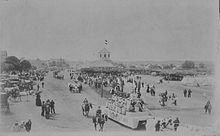History of Fredericksburg, Texas
Meusebach paid the Penateka Comanches $3,000, slightly less than $70,000 in today's money, in food, gifts, and other commodities for their participation in the signing of the agreement.
In Germany and the Catholic Church, variations have occurred on the custom of lighting hilltop evening bonfires in close proximity of Easter to celebrate the coming of spring.
In some versions of the story, the Comanches lit the fires to celebrate the signing of the treaty, and the bunnies were boiling Texas wildflowers to make the colors for the eggs.
[18] The pageant is held traditionally the Saturday before Easter, and recreates the signing of the treaty with bunny-dressed participants of all ages lighting the fires on surrounding hillsides.
[19][20] In 1845, Meusebach set out from New Braunfels, traveling 60 miles (97 km) northwest to select the second settlement of the Fisher-Miller Land Grant.
[23][24] In December 1845, on orders from Meusebach, Lieutenant Louis (Ludwig) Bene, along with lead surveyor Johann Jacob Groos[25] and crew, constructed a road from New Braunfels to the site of Fredericksburg.
[27] On April 23, 1846, the first wagon train of settlers left New Braunfels, encountering friendly Delaware Indians en route, and arrived at the Fredericksburg site on May 8, 1846.
Some even lived in linen tents which proved very inadequate during these winter months.Roemer described a diet of bear meat, corn, and coffee.
He also noted the disease of "stomachache" that engulfed the lungs and throat, was treated with citric acid, but still caused daily fatalities.
The first sheriff of the county was Louis (Ludwig) Martin,[40][41] who emigrated from Erndtebrück North Rhine-Westphalia, Germany with the first Adelsverein group aboard the Johann Detthard in 1844, and moved with the original settlers to Fredericksburg.
[42] Wilhelm Victor Keidel, who emigrated from Hildesheim, Lower Saxony, Germany, became the area's first doctor and the first elected chief justice in 1848.
[46] Local Penateka chief Santa Anna brought one of his wives to the store during a cold winter for her to give birth to a son.
[47] Pioneer Flour Mills was founded on Live Oak Creek in Fredericksburg in 1851 by Carl Hilmar Guenther, an immigrant from Weissenfels, Germany.
[50][51] Fredericksburg was primarily part of the pro-Union Texas resistance during the Civil War, but a portion of the population remained loyal to the Confederacy.
Waldrip was alleged to have been part of the notorious Die Haengebande[54] (Hanging Band) that handed out vigilante justice in the Hill Country.
[60] During the first half of the 20th century, Fredericksburg remained much like other Texas Hill County farm and ranch communities of German heritage, isolated from the commercialization of their culture.
The most notable influxes of outsiders were sporadic visitors during events such as the Easter Fires, the county fair, and hunting season, but the population and its growth remained anchored to its roots.
[22] Accompanying the dignitaries was an entourage of family members, German state officials, multiple security forces, and the national media.
The fest featured the Marychorale Choir of St. Mary's Catholic Church and Felix Pehl directing the Arlon Männerchor.
[62] On November 22, 1963, when Lyndon Johnson became President of the United States, global attention focused upon the Texas White House at nearby Stonewall.
West Germany Chancellor Ludwig Erhard visited Fredericksburg in 1963 and was greeted with "Herzlich Wilkommen" and heard a sermon in German at Bethany Lutheran Church.
[67] Fredericksburg has profited from spill-over tourism of nearby Luckenbach ever since a few events propelled the little town with a population of three to global fame.
It is gradually blending with the customs of newcomers and being replaced by tourist-oriented concepts of both German heritage and the Texas cowboy culture.
Along with like-minded individuals and organizations, the historical society is dedicated to preserving artifacts, architecture, and the history of Fredericksburg.








